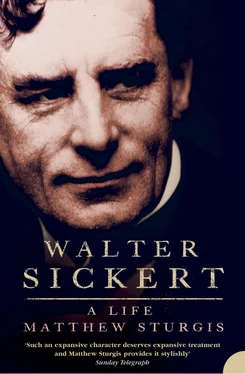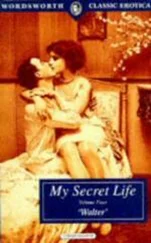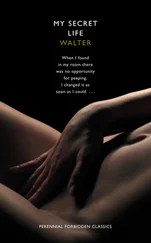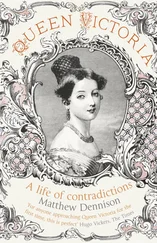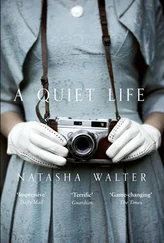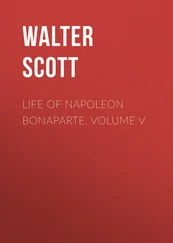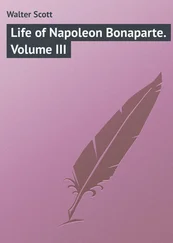Degas came to inspect Sickert’s paintings at the rue Sygogne, and was generous in his praise. He admired their finish. Passing the tips of his fingers over the smooth surface of the little panels he ‘commended the fact that they were “peint comme une porte” [painted like a door]’. 34 ‘La nature est lisse’ (Nature is smooth), he was fond of saying. 35 He did, however, raise a first doubt about the Whistlerian absence of detail and human interest in Sickert’s pictures. He urged Sickert to look at the works of Eugène Boudin, the painter of small-scale beach scenes who had inspired many of the Impressionists. 36 It was an important tip. As Sickert came to realize, where Whistler and some of the other Impressionists ‘tended to use their figures rather as spots to accentuate their landscapes’, Boudin proceeded ‘in reverse order, from the actors to the scenery’. 37 Degas also questioned another of Sickert’s Whistlerian traits: his fondness for low tones. Inspecting some of his darker pictures he remarked, ‘tout ça a un peu l’air de se passer la nuit’ (it all seems a bit like something taking place at night). 38
Buoyed up by these signs of Degas’ effectual interest, Sickert’s energy was irrepressible. George Moore, who was over on holiday, thought that no one had ever been ‘as young as Sickert was that summer at Dieppe’. He recalled him ‘coming in at the moment of sunset, his paint-box over his shoulders, his mouth full of words and laughter, his body at exquisite poise, and himself as unconscious of himself as a bird on a branch’. 39
Sickert’s mounting self-assurance did, however, lead to some moments of unexpected comedy. One chance encounter came to haunt him. Taken by a French acquaintance to see ‘a comrade of his, no longer a youth, who was thinking of throwing up a good berth in some administration in order to give himself up entirely to the practice of painting’, Sickert was introduced to a sturdy man with a black moustache and a bowler hat. ‘I am ashamed to say,’ Sickert recalled, ‘that the sketch I saw him doing left no very distinct impression on me, and that I expressed the opinion that the step he contemplated was rather imprudent than otherwise … his name was Gauguin.’ 40
A happier meeting took place outside the Dieppe fishmarket when Sickert was able to introduce Degas to his father. Oswald Sickert was working on a pastel of the Quai Henri IV, which Degas generously and genuinely admired. * Walter was delighted to be able to bring together two of his artistic progenitors. He was becoming prodigal of artistic ‘parents’, though he strove to maintain a hierarchy amongst them. Despite all the excitement of Degas’ attention, he still thought of Whistler as his principal mentor. The ‘butterfly’ arrived in Dieppe at the end of September and promptly altered the flavour of the holiday with his nervous energy and restless spirit. 41 Sickert fell into line behind his Master. Blanche was amused to see them head off together with their identical equipment and identical palettes, to set their little folding stools down in front of the same scenes. 42
This similarity of outward accoutrement, however, masked the subtle shifts in Sickert’s work that had occurred over the course of the summer. Degas’ influence and advice were already having an effect. Blanche considered that Sickert’s ‘petite planchettes’ – once so sombre – had transformed themselves ‘peu à peu sous l’influence de nos impressionistes’. 43 He also registered a change in Sickert’s increased interest in ‘figure drawing’ and in his new accentuation of ‘decorative and architectural pattern’. 44 But perhaps more significant for Sickert was seeing Whistler and Degas together. He noted the occasional tone of disparagement that Degas affected at Whistler’s grandstanding. Indeed when Sickert had first mentioned to Degas that he was ‘expecting Whistler on a visit’, the French artist had remarked, ‘Le rôle de papillon doit être bien fatigant, allez! J’aime mieux, moi, être le vieux boeuf, quoi?’ † It was a first inkling for Sickert of the sometimes overstrained tension that Whistler set up between his public pose and his private practice as a painter. 45 And it was reinforced by other similarly caustic comments. * Sickert was amazed to notice that Whistler – the terror of the London drawing rooms – was somewhat in awe of Degas, and wary of his tongue. When Whistler gave an informal lecture one evening at the rue Sygogne on ‘The Secret of Art’ – a sort of scaled down version of the Ten o’Clock Lecture – Degas, though amused, was not unduly impressed. 46 Sickert’s own status, too, was changing. He was now a married man, with an independently wealthy wife, whilst Whistler was still a not very prosperous bachelor. During the course of the holiday Sickert lent his master £5. 47
The party broke up gradually towards the end of September. Degas returned to Paris ahead of the group, though he urged Sickert and Ellen to come and visit him there before they went back to London: ‘He said we must see a great deal of him in Paris at the beginning of next month,’ Ellen reported. ‘I do think he is perfectly delightful.’ And the sincerity of his invitation was reinforced by several kind messages. 48 It was too good an opportunity to miss.
In October, Walter and Ellen were in Paris. They called on Degas and were warmly received; his only sadness was that Jane Cobden could not be there as well. (As Ellen remarked teasingly to her sister, ‘You might do worse, Janie dear!’ 49 ) He invited them to dine with him one evening, together with his ‘very best friends’, the artist Paul Bartholomé and his wife. There was also an opportunity to see his work. 50 He showed them some of his recent pastels – studies of unselfconscious women washing and drying themselves. Painters, he remarked, were too apt to make ‘formal portraits’ of women rather than allowing ‘their hundred and one gestures, their chatteries’ to inspire an infinite variety of design. ‘Je veux,’ he remarked, ‘regarder par le trou de la serrure [I wish to look through the keyhole].’ 51 The images possessed a startling directness and truth far beyond the coy eroticism or idealized fantasy of conventional late nineteenth-century nudes. Degas wondered how they would be received if he sent them to the Royal Academy. Sickert suggested they would not be received at all. ‘Je m’en doutais,’ Degas replied. ‘Ils n’admettant pas le cynisme dans l’art.’ 52
The same sense of scrupulous detachment, if not cynicism, pervaded his pictures of popular performers: ballet dancers, circus acrobats, and café singers. He even described how he had employed the services of a professional draughtsman to help him with the perspective in his painting of the trapeze artist in La La at the Cirque Fernando . 53 The world of the popular stage was one that Degas loved, and he communicated his enthusiasm to Sickert, discoursing upon his favourite performers and singing snatches of music-hall ditties. 54 Treating Sickert as a fellow practitioner, he flattered him with a fusillade of technical tips: ‘On donne l’idée du vrai avec le faux’; ‘the art of painting [is] so to surround a patch of, say, Venetian red, that it appear[s] to be a patch of vermilion’. 55 They were, for the most part, ideas that Sickert could barely as yet comprehend, but he seized on them excitedly as coming from a true master – and a master who was interested in his education.
Degas was impressed and pleased by the ardour of his visitors. He gave them introductions not only to his dealer, Durand-Ruel, but also to several private collectors who held good examples of his work. Amongst the Sickerts’ artistic pilgrimages was one to the apartment off the Champs Élysées of Gustave Mulbacher – a successful coachbuilder who owned an impressive monochrome painting of a ballet rehearsal. 56 Ellen was captivated by the work; she thought Degas’ paintings ‘simply magnificent’, almost ‘the finest in the world’. 57
Читать дальше
